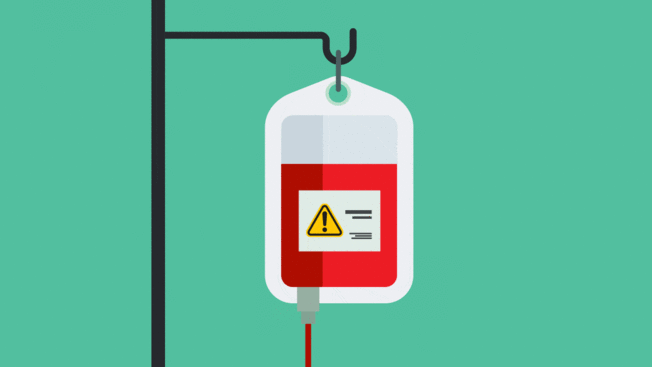Discrimination Still Keeps Many Gay and Bisexual Men From Donating Blood
In 2023, the FDA updated its guidance around blood donation eligibility. Here’s why advocates say the restrictions are outdated.

One month into his freshman year at Vassar College in Poughkeepsie, N.Y., Connor Martin and his fledgling friend group made their way to a campus blood drive. But as his friends went on to donate after answering screening questions, Martin was turned away. “When my friends asked why I was leaving so abruptly I had to explain that I’m gay and sexually active, and I can’t donate because they’re worried about HIV,” says Martin, who had yet to come out to all of his new friends. He remembers being so humiliated his voice shook, and needing to go back to his dorm room to cry.
That was in 2014. Since then, the Food and Drug Administration has revised its policy on blood donation by gay and bisexual men multiple times.
In 2015, the FDA lifted the lifelong ban preventing gay and bisexual men from donating, saying instead that they had to abstain from sexual contact with another man for 12 months. Then, in April 2020, they shortened that to three months.

Source: Connor Martin Source: Connor Martin
Blood Donations Have Declined Among Younger Donors
During World War II giving blood was seen as patriotic, and the American Red Cross collected more than 13 million pints a year. When fighting ended Americans continued to offer their blood out of a sense of civic duty.
But even before the pandemic, donations had significantly declined. “Particularly concerning, blood centers are facing double-digit decreases in donation rates among younger donors,” says Kate Fry, CEO of America’s Blood Centers, a national organization whose members operate more than 600 blood collection sites.
The lifetime ban on gay men giving blood was imposed in 1985, the year actor Rock Hudson died of AIDS-related illness. It included all men who’d had sex with another man since 1977, the year the AIDS virus is thought to have surfaced.
While Gay Men’s Health Crisis (GMHC), an HIV/AIDS service organization, is encouraged by the FDA’s changes to protocol around blood donation, Jason Cianciotto, its vice president of communications and policy, has voiced concerns around the FDA’s recommendations being “nonbinding,” as well as its use of outdated data to assess the HIV risk with regard to men who have sex with other men.
Updated Guidance for Gay and Bisexual Men Who Donate Blood
In May 2023, the FDA eliminated time-based deferrals and screening questions specific to men who have sex with men and women who have sex with men who have sex with men. Under this final guidance, all prospective blood donors will answer a series of individual, risk-based questions to determine their eligibility under the aforementioned sexual encounter windows.
The FDA reviewed numerous data sources, including data from countries with similar HIV epidemiology that now use an individual risk-based approach for reviewing donor eligibility, as well as the FDA-funded Assessing Donor Variability And New Concepts in Eligibility (ADVANCE) study to determine whether a different donor policy can be used at blood centers nationwide while maintaining the safety of the blood supply. The study examined rates of HIV risk factors, as well as the use of medications to treat or prevent HIV infection among nearly 2,000 participants recruited from Atlanta; Los Angeles; Memphis, Tenn.; Miami; New Orleans; Orlando, Fla.; and Washington, D.C.
Other countries are also taking action. In November 2015, the French Ministry of Health announced that all adult citizens, regardless of their sexual orientation, would be able to donate blood without time-based restrictions after answering screening questions to assess their risk of exposure. Italy, Spain, and the United Kingdom, have made similar changes to their blood donation screening processes.
What to Know Before Donating Blood
If you plan to donate blood, here are a few things to know:
- Find a donation site near you. There are hundreds of blood donation sites across the country. In addition to fixed donation centers, locations such as churches and even some restaurants have been used as pop-up sites. America’s Blood Centers and the American Red Cross have tools that you can use to find the collection site nearest to you.
- Safety matters. While strict rules about masking, social distancing, and other COVID-mitigation activities aren’t seen much anymore, the American Red Cross follows state and local ordinances, as well as the requests of blood drive sponsors. When you phone ahead to make an appointment at a Red Cross donation center, spend a few minutes on the Red Cross blood donor app or online to get a RapidPass, which allows you to save time at your appointment by answering a few basic questions about your health history and reading pre-donation materials ahead of time. The pass is active for 24 hours and you can print them or download them to your smartphone.
- After donating once, consider donating again. Whole blood donations can be given every 56 days, but there are other types of blood products you can also donate. Platelet donations to harvest the tiny cells responsible for clotting can be done every seven days. Plasma is used in emergency situations and can be given to anyone regardless of their blood type. AB plasma can be donated every 28 days. Power red donations take a concentrated dose of red cells and typically treat newborns, trauma patients, and people with sickle cell anemia; these donations are possible every 112 days. Whichever donation you choose to make, the blood center will gladly schedule your next appointment before you leave.
- Diverse donors are especially needed to account for conditions that disproportionately impact one community. Sickle cell anemia, an inherited red blood cell disorder that hampers blood’s ability to carry oxygen, is managed in part by blood transfusions. The condition primarily affects people in the Black community, creating an especially urgent need for Black donors, whose blood types may provide the most compatible match.
If you can’t donate blood for some reason, you may still consider donating your time by volunteering at a blood center or by organizing an in-person or virtual blood drive.




















